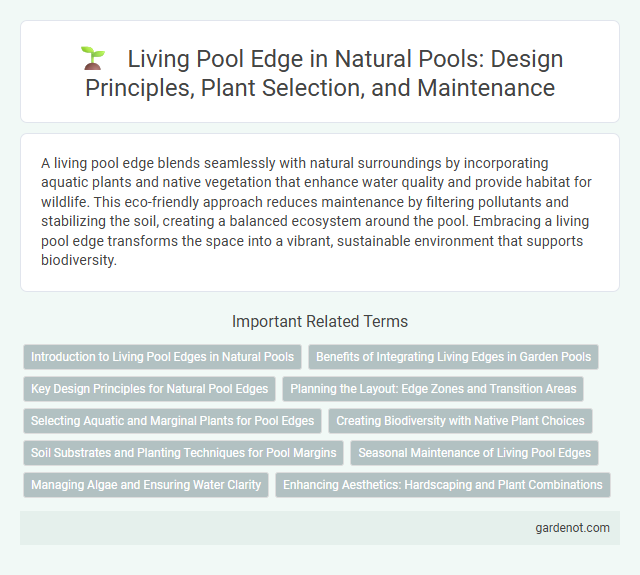A living pool edge blends seamlessly with natural surroundings by incorporating aquatic plants and native vegetation that enhance water quality and provide habitat for wildlife. This eco-friendly approach reduces maintenance by filtering pollutants and stabilizing the soil, creating a balanced ecosystem around the pool. Embracing a living pool edge transforms the space into a vibrant, sustainable environment that supports biodiversity.
Introduction to Living Pool Edges in Natural Pools
Living pool edges in natural pools integrate native aquatic plants and natural materials to create a seamless transition between water and landscape. These edges enhance biodiversity by providing habitats for insects and amphibians while improving water quality through natural filtration. The combination of biofiltration and aesthetic appeal positions living pool edges as a sustainable alternative to traditional pool boundaries.
Benefits of Integrating Living Edges in Garden Pools
Integrating living pool edges in garden pools enhances biodiversity by providing habitats for aquatic plants and beneficial microorganisms, which naturally improve water quality. These bioactive zones reduce the need for chemical treatments and promote ecological balance through natural filtration and oxygenation. Living edges also create visually appealing, seamless transitions between water and garden, increasing the aesthetic and environmental value of outdoor spaces.
Key Design Principles for Natural Pool Edges
Natural pool edges prioritize biodiversity and seamless integration with the surrounding landscape by using native plants and natural materials like stones and gravel to create stable, erosion-resistant boundaries. Key design principles include maintaining gradual slopes for safe water access, incorporating a diversity of aquatic and marginal plants to enhance water filtration and habitat complexity, and ensuring unobstructed sunlight to support photosynthesis and aquatic life. Effective edge design also balances aesthetic appeal with functional water purification, resulting in a harmonious blend of ecology and recreation.
Planning the Layout: Edge Zones and Transition Areas
Planning the layout of a living pool edge emphasizes defining clear edge zones and smooth transition areas to enhance ecological balance and aesthetic appeal. Delineating zones such as the regeneration zone, shallow planting shelves, and deeper swimming areas promotes diverse aquatic plant growth and natural filtration. Integrating gradual slopes and varied textures in transition areas ensures seamless blending between water and landscape, supporting habitat complexity and water quality.
Selecting Aquatic and Marginal Plants for Pool Edges
Selecting aquatic and marginal plants for living pool edges enhances water filtration and natural habitat creation. Species like water irises, pickerelweed, and bulrushes thrive in shallow waters, stabilizing the substrate and preventing erosion. Incorporating diverse native plants promotes biodiversity while maintaining clear, balanced water conditions in natural swimming pools.
Creating Biodiversity with Native Plant Choices
A living pool edge enhances water quality and habitat diversity by incorporating native aquatic and marginal plants specifically adapted to the local climate and soil conditions. Selecting species such as sedges, rushes, and wildflowers encourages beneficial insects, amphibians, and birds to thrive, boosting ecosystem resilience. Native plants also reduce maintenance needs by requiring less water and fertilizer, contributing to a sustainable and balanced natural pool environment.
Soil Substrates and Planting Techniques for Pool Margins
Soil substrates in living pool edges provide essential filtration and habitat functions, with layers designed to support diverse aquatic plants that improve water quality through natural biofiltration. Selecting native, moisture-tolerant species with deep root systems enhances soil stabilization and nutrient uptake along pool margins, reducing erosion and promoting biodiversity. Effective planting techniques involve graduated planting zones and substrate mixtures optimized for water retention and aeration, ensuring healthy plant growth and sustainable pool ecosystem balance.
Seasonal Maintenance of Living Pool Edges
Seasonal maintenance of living pool edges involves careful pruning of aquatic plants to prevent overgrowth and ensure healthy water filtration. Regular removal of debris and monitoring of water quality help sustain the natural ecosystem balance, promoting biodiversity in the pool environment. Inspecting and adjusting soil or substrate conditions supports root health and plant vitality across changing weather conditions.
Managing Algae and Ensuring Water Clarity
A living pool edge acts as a natural biofilter, where aquatic plants and beneficial microorganisms collaborate to manage algae growth effectively. These biological components consume excess nutrients, which are primary contributors to algae blooms, thus maintaining water clarity. Regular monitoring of plant health and nutrient levels ensures a balanced ecosystem that supports clear, algae-free water.
Enhancing Aesthetics: Hardscaping and Plant Combinations
Natural pool living edges blend hardscaping materials such as natural stone and timber with lush, native plants like reeds, sedges, and ornamental grasses to create a visually striking transition between water and land. Combining textured rock formations with vibrant aquatic plants enhances biodiversity and fosters a seamless integration of the pool into the surrounding landscape. Strategic placement of these elements promotes natural filtration, improves water clarity, and elevates the overall aesthetic appeal of the pool environment.
Living pool edge Infographic

 gardenot.com
gardenot.com